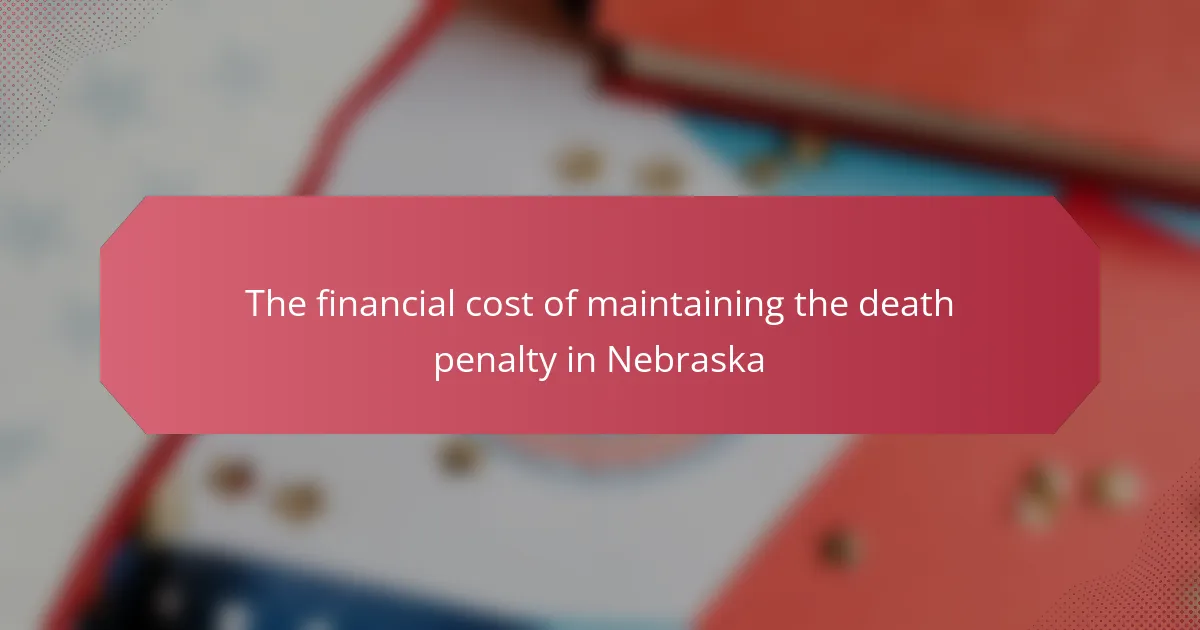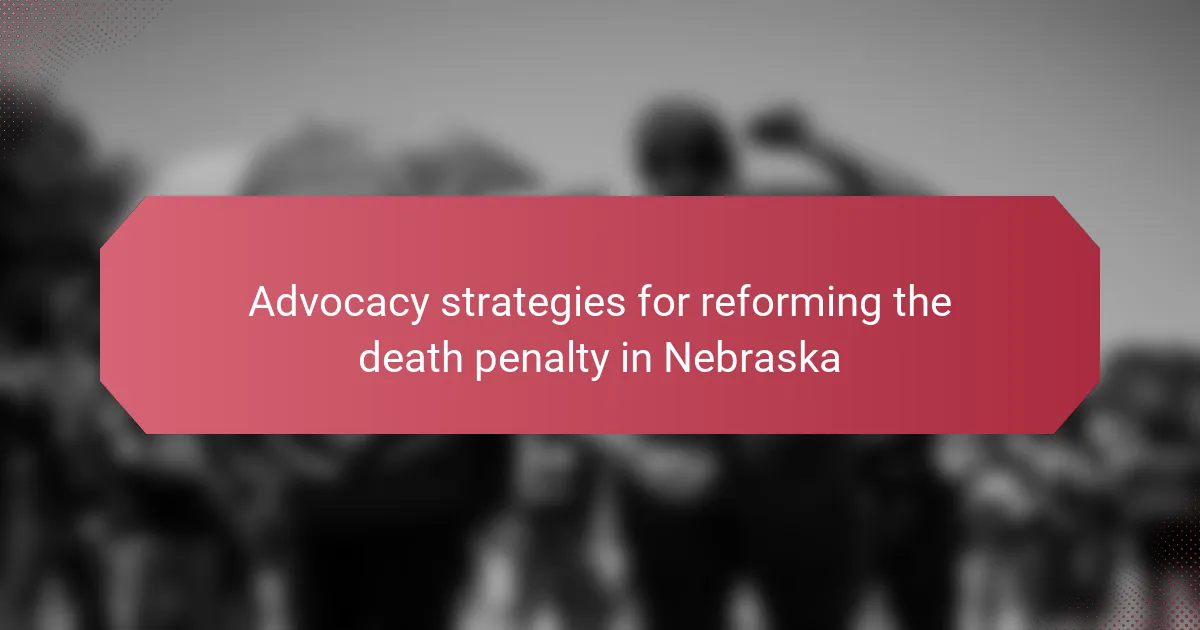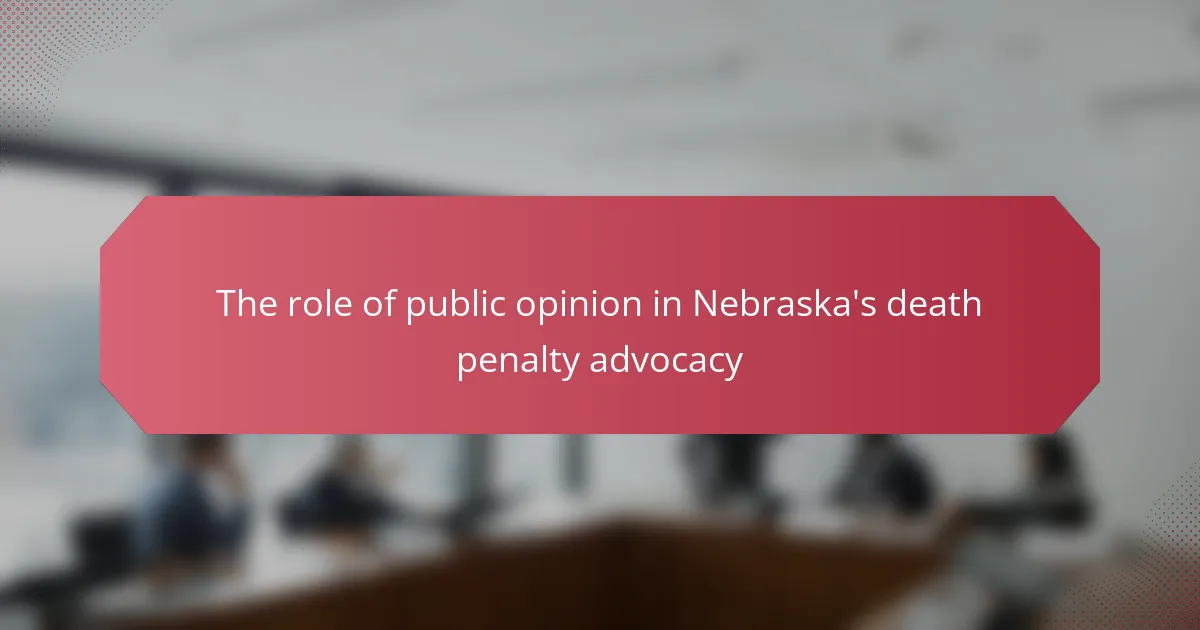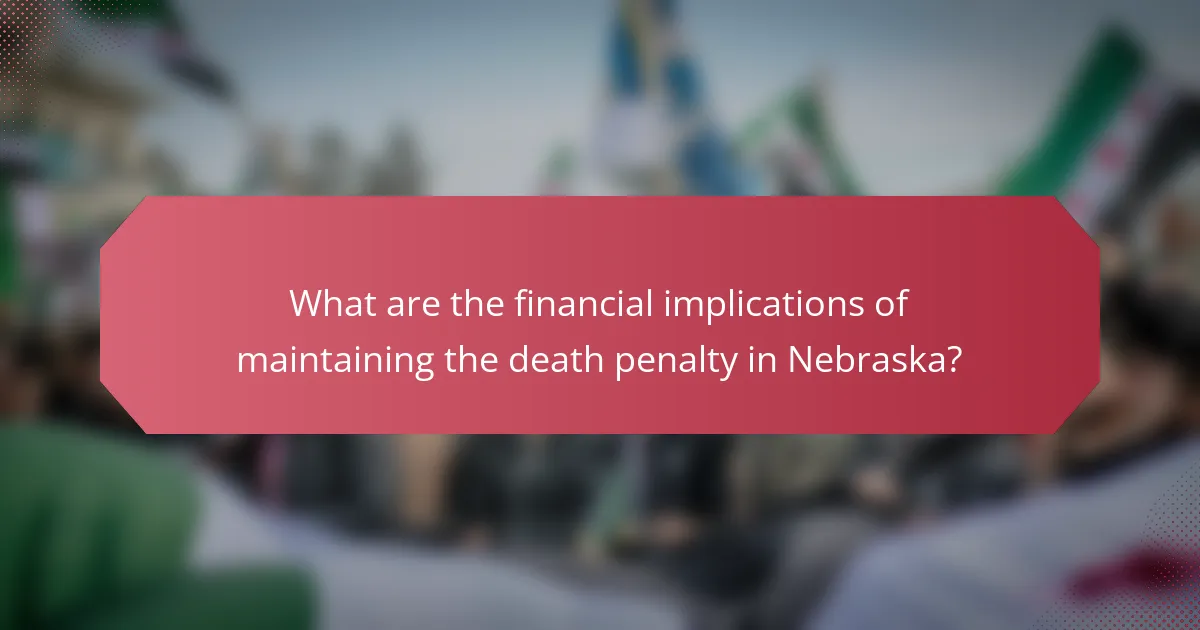
What are the financial implications of maintaining the death penalty in Nebraska?
Maintaining the death penalty in Nebraska incurs significant financial implications. The costs associated with capital punishment are notably higher than those for life imprisonment. Legal expenses for death penalty cases can exceed $1 million, including trials and appeals. Additionally, the state bears the cost of prolonged incarceration on death row, which averages about $90,000 per inmate annually. A 2015 report indicated that Nebraska spent approximately $3 million annually on the death penalty system. These factors contribute to an overall financial burden that raises questions about the efficacy and morality of maintaining capital punishment.
How does the cost of the death penalty compare to life imprisonment?
The cost of the death penalty is significantly higher than that of life imprisonment. In Nebraska, the estimated cost for a death penalty case can exceed $1 million. This includes expenses for legal representation, trials, and lengthy appeals. In contrast, life imprisonment without parole typically costs around $500,000. The financial burden of the death penalty is largely due to the extensive legal processes involved. Studies, such as those from the Nebraska Commission on Public Advocacy, highlight these stark differences in costs.
What are the direct costs associated with capital cases?
The direct costs associated with capital cases include legal fees, trial expenses, and incarceration costs. Legal fees can range significantly, often exceeding $1 million. Trial expenses include jury selection, expert witnesses, and additional court costs, which can also total hundreds of thousands of dollars. Incarceration costs for death row inmates are higher than for those in general population due to increased security measures. Studies have shown that capital cases are often three to four times more expensive than non-capital cases. Additionally, the lengthy appeals process incurs further costs, sometimes lasting decades. These figures highlight the substantial financial burden of capital cases on the judicial system.
What additional expenses arise during the appeals process?
Additional expenses during the appeals process include attorney fees, court costs, and expert witness fees. Legal representation can be costly, often exceeding tens of thousands of dollars. Court costs encompass filing fees and costs associated with transcripts and record preparation. Expert witness fees can also add significant expenses, as they may be required to testify on various aspects of the case. These costs can accumulate rapidly, making the appeals process financially burdensome. In Nebraska, the average cost of a death penalty appeal can reach up to $1 million, highlighting the substantial financial impact of these additional expenses.
What factors contribute to the overall financial burden of the death penalty?
The overall financial burden of the death penalty is influenced by several key factors. Legal costs are significant, including expenses for defense attorneys and prosecutors. Trials for death penalty cases are typically longer and more complex, leading to increased court costs. Additionally, the appeals process is extensive and costly, often lasting years. Housing death row inmates incurs higher expenses due to increased security and specialized facilities. Execution costs, including the use of lethal injection drugs, also contribute to the financial burden. A study by the Nebraska Legislative Fiscal Analyst reported that death penalty cases can cost the state millions more than life imprisonment cases. These factors collectively create a substantial financial impact on the state’s budget.
How does the length of the legal process impact costs?
The length of the legal process significantly increases costs associated with the death penalty. Prolonged legal proceedings lead to higher attorney fees and extended court costs. Each phase of the legal process, including trials, appeals, and post-conviction reviews, incurs substantial financial expenses. In Nebraska, for instance, the average cost of a death penalty case can exceed $1 million, primarily due to lengthy litigation. Studies indicate that cases with extended legal processes are often more expensive due to the need for expert witnesses and additional legal resources. Consequently, the duration of legal proceedings directly correlates with escalating costs in death penalty cases.
What role do legal representation and public defense costs play?
Legal representation and public defense costs significantly impact the financial burden of maintaining the death penalty in Nebraska. These costs encompass attorney fees, expert witness expenses, and administrative overhead. Public defense costs arise when defendants cannot afford private counsel, necessitating state-funded legal representation. According to a 2016 study by the Nebraska Legislative Fiscal Office, the average cost of defense in death penalty cases can exceed $1 million. This figure includes trial costs, appeals, and post-conviction proceedings. Additionally, legal representation is crucial for ensuring fair trials and upholding constitutional rights. The high costs of legal representation contribute to the overall financial implications of the death penalty system in the state.
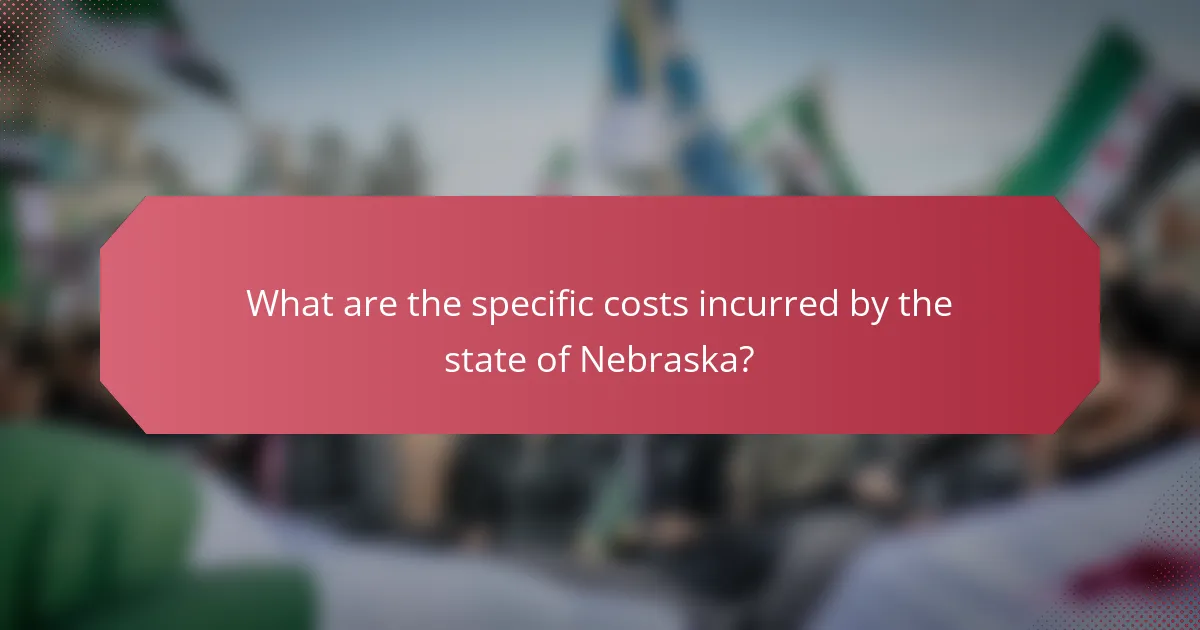
What are the specific costs incurred by the state of Nebraska?
The specific costs incurred by the state of Nebraska for maintaining the death penalty include legal expenses, incarceration costs, and execution expenses. Legal expenses encompass attorney fees for both prosecution and defense, which can exceed $1 million per case. Incarceration costs involve housing death row inmates, averaging around $90,000 annually per inmate. Execution expenses include the costs of lethal injection drugs and the execution process itself, which can total approximately $200,000. According to a 2015 report by the Nebraska Commission on Public Advocacy, the total cost of a death penalty case is significantly higher than that of a life sentence without parole, often exceeding $1.5 million. These figures illustrate the substantial financial burden the death penalty imposes on the state.
How much does the state spend on incarceration for death row inmates?
The state spends approximately $1.3 million annually on incarceration for each death row inmate. This figure includes costs for housing, security, and healthcare services. Nebraska has a small number of death row inmates, which influences the overall expenditure. The total cost for maintaining the death penalty in Nebraska is significantly higher when considering legal fees and other related expenses. Studies indicate that the financial burden of the death penalty is often greater than that of life imprisonment without parole.
What are the costs of housing and feeding death row inmates?
The costs of housing and feeding death row inmates in Nebraska are significant. On average, it costs approximately $60,000 per inmate per year. This figure includes expenses for food, medical care, and security. Housing death row inmates requires specialized facilities, increasing operational costs. In Nebraska, these costs are higher than for general prison populations. Research indicates that maintaining death row inmates can be up to 2.5 times more expensive than housing regular inmates. This financial burden impacts state budgets and resources allocated to other public services.
How do security measures for death row impact state budgets?
Security measures for death row significantly impact state budgets. Implementing high-security protocols requires substantial financial resources. States must allocate funds for enhanced surveillance, staffing, and infrastructure. For example, additional personnel are needed to monitor inmates continuously. This results in increased labor costs. Moreover, specialized training for staff adds to the budget. Security measures also necessitate advanced technology, which incurs further expenses. In Nebraska, these costs can lead to millions of dollars annually. A study by the Nebraska Commission on Public Advocacy highlights that maintaining death row is considerably more expensive than life imprisonment without parole.
What are the administrative costs associated with the death penalty?
The administrative costs associated with the death penalty are significant. These costs include expenses for legal representation, court proceedings, and lengthy appeals. Studies indicate that death penalty cases can cost up to three times more than life imprisonment cases. For example, a report from the Nebraska Legislative Fiscal Office estimated that the death penalty costs the state approximately $14 million per execution. This figure encompasses trial costs, incarceration, and post-conviction processes. Additionally, the extended duration of death penalty cases increases costs related to public defense and prosecutorial resources. Overall, the financial burden of administering the death penalty is substantial and ongoing.
How much does the state allocate for judicial and prosecutorial resources?
The state allocates approximately $3.3 million annually for judicial and prosecutorial resources related to the death penalty in Nebraska. This funding covers costs associated with legal representation, court proceedings, and other judicial processes. According to the Nebraska Commission on Public Advocacy, these resources are essential for ensuring fair trials and adequate defense for capital cases. Additionally, the allocation reflects the state’s commitment to upholding legal standards in death penalty cases.
What are the costs of training law enforcement and legal personnel?
The costs of training law enforcement and legal personnel can vary significantly. On average, law enforcement training programs can range from $3,000 to $10,000 per officer. This includes tuition, materials, and facility costs. Additionally, ongoing training expenses can add several thousand dollars annually per officer. For legal personnel, such as attorneys, costs can exceed $100,000 for law school education. Furthermore, continuing legal education may cost around $1,500 to $3,000 annually. These expenses contribute to the overall financial burden associated with the legal system, including the maintenance of the death penalty in Nebraska.
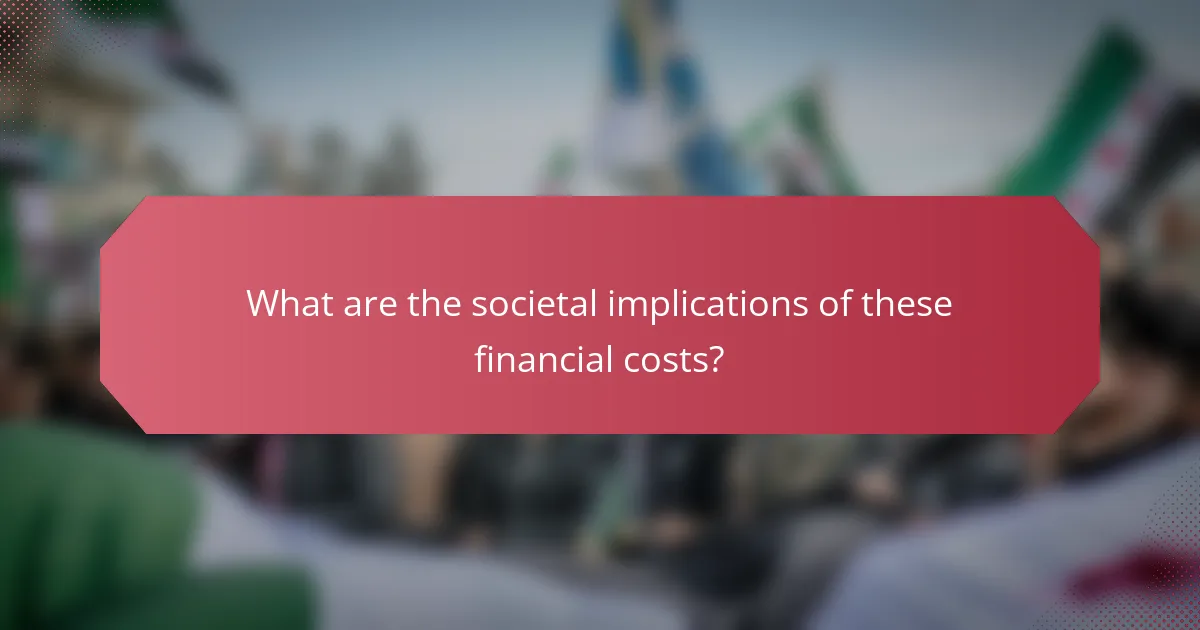
What are the societal implications of these financial costs?
The societal implications of the financial costs of maintaining the death penalty in Nebraska include strained state budgets and potential shifts in public opinion. High costs associated with legal proceedings and incarceration can divert funds from essential services like education and healthcare. In Nebraska, estimates suggest that the death penalty costs taxpayers millions annually. This financial burden may lead to debates about the effectiveness and morality of capital punishment. As public awareness of these costs grows, it can influence voter sentiment and policy decisions. Additionally, the allocation of limited resources may exacerbate social inequalities. The financial implications thus extend beyond economics, affecting community trust in the justice system and government accountability.
How do public opinions influence funding for the death penalty?
Public opinions significantly influence funding for the death penalty. When public sentiment supports the death penalty, legislators are more likely to allocate funds for its enforcement. Conversely, if public opinion shifts against it, funding may decrease or be redirected. For instance, surveys show that a majority of Nebraskans have fluctuated in their support for capital punishment over the years. In 2015, a poll indicated that 61% of Nebraskans favored the death penalty, while by 2020, support had dropped to 51%. This change can lead to legislative actions that either bolster or cut funding. Additionally, advocacy groups often mobilize public opinion to influence budget decisions related to the death penalty. Research indicates that states with declining public support have seen corresponding reductions in death penalty funding.
What trends are observed in public support for the death penalty in Nebraska?
Public support for the death penalty in Nebraska has shown a decline in recent years. According to a 2021 poll by the Nebraska Institute of Public Policy, 58% of respondents supported the death penalty, down from 75% in 2016. This trend indicates a growing sentiment against capital punishment among Nebraskans. Factors influencing this shift include concerns over wrongful convictions and the high costs associated with death penalty cases. Additionally, the Nebraska legislature has seen increased discussions around alternatives to capital punishment. These discussions reflect changing public attitudes towards justice and punishment in the state.
How do financial arguments affect public perception of capital punishment?
Financial arguments significantly influence public perception of capital punishment. Many people view the death penalty as an expensive legal process. Studies indicate that the cost of capital trials, appeals, and incarceration is higher than life imprisonment. In Nebraska, the estimated cost of a death penalty case can exceed $1 million. This financial burden raises questions about the effectiveness and justification of capital punishment. Public opinion often shifts towards favoring alternatives when faced with these financial realities. Economic arguments highlight the need for budgetary efficiency in the justice system. As awareness of these costs grows, support for the death penalty may decline.
What alternatives could reduce the financial burden of the death penalty?
Life imprisonment without parole is a key alternative that could reduce the financial burden of the death penalty. This option eliminates the lengthy and expensive legal processes associated with capital cases. Studies indicate that life sentences are significantly less costly than death penalty cases. For instance, a Nebraska study found that death penalty cases can cost up to $1 million more than life imprisonment. Additionally, life sentences avoid the costs of prolonged incarceration on death row. Implementing restorative justice programs can also reduce costs by focusing on rehabilitation rather than punishment. These alternatives provide a more cost-effective approach while addressing public safety concerns.
How does transitioning to life imprisonment impact state finances?
Transitioning to life imprisonment significantly reduces state financial burdens. Life imprisonment typically incurs lower costs compared to the death penalty. The average annual cost of housing an inmate in Nebraska is approximately $35,000. In contrast, the legal and procedural expenses associated with death penalty cases can exceed $1 million. These costs include lengthy trials, extensive appeals, and heightened security measures. States that have abolished the death penalty often report substantial savings. For instance, a study in California indicated that replacing the death penalty with life imprisonment could save over $5 billion. Thus, transitioning to life imprisonment can lead to considerable financial relief for state budgets.
What are the potential savings from reforming the justice system?
Reforming the justice system can lead to significant financial savings. States that have abolished the death penalty report savings of millions annually. For example, a study in California estimated that replacing the death penalty with life imprisonment could save $137 million per year. Nebraska’s costs for death penalty cases are notably high, with the average cost per execution exceeding $1 million. In contrast, life sentences without parole are considerably less expensive. Reforming the justice system to eliminate the death penalty can thus redirect funds towards other public services.
What strategies can be implemented to manage the financial costs of the death penalty?
Implementing strategies to manage the financial costs of the death penalty includes reducing the number of death penalty cases. Fewer cases can lead to lower legal expenses and resource allocation. Streamlining the legal process is also essential. This can minimize the duration of trials and appeals, which are costly. Utilizing alternative sentencing options can further alleviate financial burdens. Life imprisonment without parole is a less expensive option compared to capital punishment. Additionally, improving public defense systems can enhance efficiency. A well-resourced public defense can reduce delays and costs associated with prolonged trials. Lastly, conducting thorough cost-benefit analyses can inform policymakers about the financial implications of maintaining the death penalty. This data-driven approach can guide future decisions on the practice.
The primary entity of this article is the financial cost associated with maintaining the death penalty in Nebraska. The article outlines the substantial financial implications of capital punishment, highlighting that costs for death penalty cases can exceed $1 million, significantly higher than life imprisonment. It details direct expenses such as legal fees, trial costs, and prolonged incarceration, alongside the financial burden of the appeals process. Additionally, the article discusses societal implications, public opinion trends, and potential alternatives that could alleviate the financial strain on the state’s budget.
